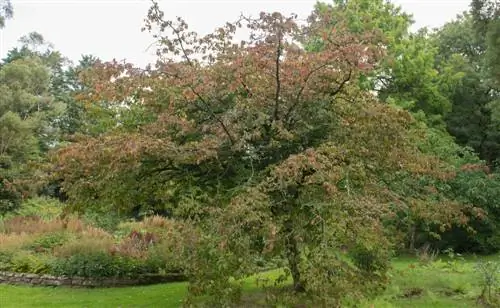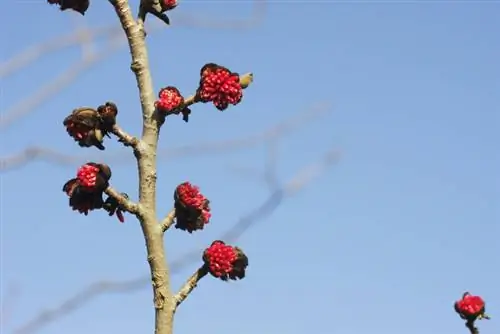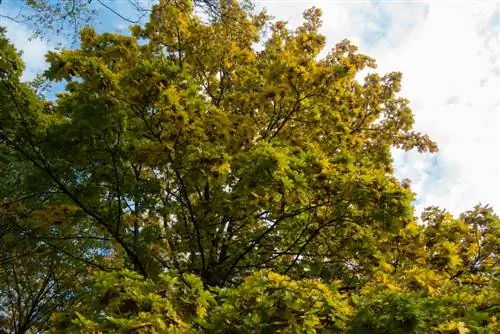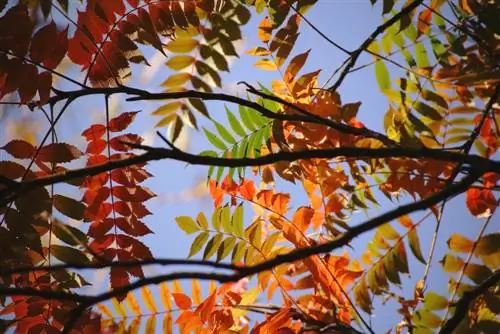- Author admin [email protected].
- Public 2023-12-25 17:45.
- Last modified 2025-01-23 11:21.
Ironwood trees have very special properties that make them popular ornamental trees. They shine in gardens with breathtaking autumn color. Once you have found the right location, the tree requires little care. There are now varieties that are also suitable for small gardens.
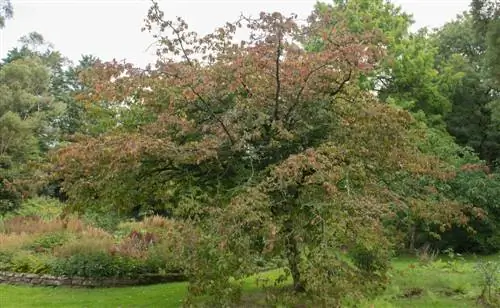
What is special about the ironwood tree?
The ironwood tree (Parrotia persica) is a slow-growing ornamental tree from the Middle East that is valued for its breathtaking autumn color and smooth, cracked bark. It can reach a height of 10-12 meters and is suitable as a solitary tree or bonsai. Easy to care for and adaptable, it prefers a slightly acidic, permeable clay soil and a sunny to partially shaded location.
Origin
Parrotia persica describes the ironwood tree, also known as parrotia. Its natural home is in the Near East, where it prefers to grow in lowland forests with moist conditions. The suffix persica indicates its distribution area in Persia, which corresponds to today's Iran. Here the tree grows in the northern part. Other areas exist southwest of the Caspian Sea. The ironwood tree is the only species within the genus Parrotia that is part of the witch hazel family.
In Europe, the tree is a popular ornamental plant in public parks. Its triumphal march began here in 1846. The parrot, which was named after the German doctor Friedrich W. Parrot, can be found in numerous botanical gardens.
Growth
The ironwood tree grows predominantly as a shrub with several trunks. Some specimens develop a main trunk that branches close to the ground and develops a crown. Tree-shaped parrotia are noticeably low. The species develops a root system that creeps shallowly beneath the soil surface.
As a deciduous tree, the parrotia sheds its leaves in autumn. The tree has achieved a low annual growth rate after many years of growing heights of between ten and twelve meters. Due to the slow growth, a very hard and dense wood structure develops, which makes the tree a valuable building material.
Typical of the trees is the very smooth bark, which is colored olive green. In winter the bark becomes increasingly cracked and flakes off in small scales. This creates different colored sections that are distributed across the trunk like a puzzle, like plane trees. The young branches have bark covered with star hairs. They strive upwards in an arc, so that the crown usually appears funnel-shaped. As it gets older it develops a broad, sweeping shape.
Bloom
Parrotia bloom before the leaves appear. Eight to ten individual flowers are clustered together in a terminal inflorescence that appears head-like. The inflorescences are surrounded by dark brown bracts. The flowers can be hermaphrodite or purely male.
They have no strikingly colored petals and between five and seven inconspicuous sepals. These are green in color and end in a brownish tip. The red anthers hanging from long stamens are striking. The flowering period of ironwood trees begins in January when the winter has been particularly mild. The flowers appear in March at the latest.
What makes the flowers so unique:
- Adaptation to wind pollination
- do not develop nectar
- Trees save energy by not developing petals
Fruit
After the flowering period, inconspicuous capsule fruits appear on the hermaphrodite flowers. They can develop two to four valves containing numerous shiny light brown seeds. The fruits open explosively along pre-formed structures and eject the elongated to elliptical seeds, which spread with wind and rain.
leaves
Ironwood trees develop alternate leaves whose leaf blades are obovate. Their shape appears slightly asymmetrical. Above the middle of the leaf, the edge is covered with curved teeth. The leaf base is rounded or slightly heart-shaped. The short-stemmed leaves grow between six and ten centimeters long and are hairy on the top and bottom.
From a distance, the leaves are reminiscent of the foliage of copper beeches. When they sprout fresh, they are reddish in color. As it ages, the leaves turn dark green. Ironwood trees are attractive because of their aesthetic autumn color. Shortly before winter, the trees shine in bright yellow and orange tones with reddish nuances or burgundy red.
Usage
The crown of the ironwood trees appears ornamental and expansive. Due to this growth habit, the Parrotia is perfect for displaying alone in parks and gardens. The species is well suited for medium-sized gardens as it grows slowly and does not require too much space. When it gets older, the tree reaches the size of a large pear tree.
The specimens cultivated as standard trees are popular avenue trees on streets and park paths. Its popularity arose from its attractive autumn colors. In New Zealand the flowering period shifts to December. Here the inflorescences are a popular Christmas decoration.
Bonsai
Parrotia are suitable as bonsai. They are formed by cutting measures and can be made into different shapes. The style of the freely upright tree shape is preferred. To do this, you must prune the tree regularly in the first few years. The ironwood tree tolerates radical pruning. You can remove all side branches from the main trunk except for one leafy shoot. After a year, many side shoots have formed on the main trunk, which can then be further shaped.
Tips for designing an ironwood tree bonsai:
- fresh shoots should be wired
- Once the desired design shape has been achieved, the bonsai is planted in a bowl
- Put bonsai outside in summer
Is ironwood tree poisonous?
Parrotia persica is considered non-toxic. There are no known symptoms of poisoning. You can safely plant the tree in gardens where there are children or pets.
Which location is suitable?
The adaptable ironwood tree can cope with different soil types. It grows in both moderately dry and moist locations. The species tolerates periods of heat. The autumn colors are particularly intense in full sun. You can also plant the parrotia in partially shaded places. Locations exposed to wind cause problems for the tree.
What soil does the plant need?
The parrot prefers a slightly acidic clay soil with a permeable structure. Prevent waterlogging of the soil, as excessive moisture promotes rotting processes in the root area. Heavy clay soils should be loosened with sand. A humus-rich substrate provides ideal growth conditions. The pH value of the soil is a maximum of 7. If your soil has a higher value, you should incorporate special fertilizer or peat into the substrate.
Propagation
An easy method of propagation is lowering shoots growing close to the ground. Bend the branches down to the ground and score the upper part of the shoot in a cross pattern. At this point, the branch is fixed to the ground with a stone so that the scratched area has permanent contact with the substrate. The tip sticks out from under the stone.
Root formation requires patience. After two years, the shoot has developed enough roots that it can be separated from the mother plant. Plant the sinker in the desired location.
Sowing
You can cut off the fruit heads before the capsule fruits have opened. Store the shoots in a tall container and place it in a warm and sunny place. Here the fruits continue to ripen until the capsules burst open and the seeds are released.
Sprinkle the seeds onto a moist growing substrate and cover the container with a transparent film. The seeds germinate under optimal conditions after three weeks at the earliest and eight weeks at the latest. It can take up to ten years for plants propagated from seedlings to bloom for the first time. The autumn color of these plants can be very different. Please note that this propagation method does not produce true-to-variety offspring. The young plants develop different combinations of the traits they inherited from their parent plants.
Cuttings
Cut off shoots between 15 and 20 centimeters long directly below a leaf node. The lower half of the cutting is defoliated. Dip the cut site in a bowl of willow water. The growth hormones from the willow branches stimulate root formation.
How to make willow water:
- cut annual shoots into small pieces
- Put the leaves and shoots in a large bowl
- pour boiling water over it
- leave covered for 24 hours
The cuttings are placed in a cultivation container with a sand-peat mixture. Moisten the substrate and place a glass over the planter. You can also place the pots in a greenhouse in a bright location with temperatures between 22 and 25 degrees Celsius. It takes between two and four weeks for the cuttings to form their first roots.
Ironwood tree in a pot
Due to their slow growth, young ironwood trees are suitable for container cultivation. Choose a large container with the widest possible diameter as the trees root shallowly in the substrate. A drainage hole in the pot ensures water drainage. Pour off excess water from the saucer so that moisture does not build up in the substrate. A mixture of loamy soil and sand is suitable as a substrate. When the plants become too small for the container, they should be transplanted into the garden.
Balcony
As a young plant in a pot, the ironwood tree spends the year outdoors. As a potted plant, it beautifies sunny balconies and terraces that offer a sheltered location from the wind. In winter you can leave the tree outside. Make sure the bucket has appropriate winter protection. To prevent the root ball from freezing, you should generously wrap the pot with plastic wrap and place it on a Styrofoam plate or a piece of wood.
Watering ironwood tree
Ironwood trees have moderate water requirements. They only need to be watered during long dry periods. If you cultivate your plant in a container, ironwood trees enjoy regular watering
Fertilize ironwood trees properly
In spring, fertilize the plant with compost that you work into the soil. An additional supply of nutrients is not necessary for outdoor trees. Potted plants should be supplied with a mineral fertilizer every four weeks. The supply will take place until September. The tree then goes into hibernation and does not require any further fertilization until spring.
Cutting ironwood trees correctly
The sprawling crown of the parrotia rarely needs to be cut back if some branches disturb the image. Choose a cool day between March and April after the flowers have faded. For the cut, use sharp secateurs whose blades have been thoroughly cleaned.
To avoid unsightly cuts and stumps, you should be careful when pruning. Avoid radically cutting back into the old wood. The tree sprouts even after radical cuts. However, this measure destroys the aesthetic form.read more
Wintering
Mature specimens that are well rooted can tolerate temperatures down to -20 degrees Celsius. In particularly harsh winter months, additional protective measures are recommended. Wrap the trunk and crown with mats made of reeds or jute ribbons. They act as an insulating layer from the icy cold. Cover the root area with coconut mats and spread leaves and brushwood on the base.
Young plants need winter protection in the first few years, even at temperatures below zero. From July onwards, avoid using fertilizers containing nitrogen, as these prevent the wood from maturing and the branches become susceptible to frost damage.
How do I transplant correctly?
You should pay attention to the growth height of the parrotia when planting, as it is difficult to transplant mature trees late. With this measure, the shallow-rooted plant loses numerous roots and can no longer adequately support the mighty crown at the new location. Trees that are too badly damaged often die after being transplanted.
Pests
The black weevil occasionally attacks ironwood trees. The pest feeds on the leaf mass and lays its eggs on the substrate. The larvae damage the fine roots. Nematodes, which are administered via irrigation water, fight the larvae. Beetles should be collected regularly at dusk. A nematode trap has proven effective for pest control.
Fungal infestation
If dried leaves are not due to incorrect care or suboptimal site conditions, the colonization of spores may be the cause.
Verticillium wilt
Wilting leaves indicate an infestation by verticillium fungi, which causes young trees to die. Older trees can often fight the fungal disease on their own. It is not uncommon for chronic infections to occur afterwards, in which shoots die. Remove affected plant parts generously and dispose of them with household waste.
Phytophthora
The fungi within this genus are responsible for root rot. If the disease has spread significantly, the tree may die. Waterlogging promotes the spread of spores. The fungal infestation cannot be actively combated. Infected trees should be removed so that the spores do not spread any further.
Tip
Spread bark mulch over the substrate. The shredded wood waste protects the soil from drying out and keeps it warm. The valuable nutrients from the wood pieces are released when soil organisms decompose the material. They increase the vitality of the tree. At the same time, bark mulch creates a decorative look and a harmonious image.
Varieties
- Vanessa: Magnificent autumn color with yellow, orange, red, pink and violet hues. Yellow capitate flowers with red stamens. Growth height between eight and twelve meters.
- Persian Spire: Narrow growth, aspiring. Shoots violet, leaves dark green in summer with a violet edge. Autumn colors yellow, orange and purple. Growth height up to 250 centimeters.
- Bella: Leaf shoots wine-red, leaves turn green, colored deep red in autumn. Grows between eight and ten meters high.

